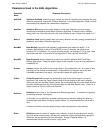
Using The Reverb Program Lexicon, Inc.
Reverberation and Reality, Continued
5-4
length that is perceived, and the behavior of the
reflections can be quite different when the sound event
is short compared to when the sound event is long.
Notes which are shorter than the time constant of the
reverberation, ~RT/7, will excite the reverberation less
strongly than longer notes.
There is another peculiarity of background
envelopment. It depends on the absolute level of the
reverberation, and not the direct/reverberant ratio. If we
play the music louder the reverberation will be louder,
and the sound will be more enveloping. Thus when we
mix for envelopment we must be very careful about our
monitor levels, and aware of how loud the critical
customer will play our mix.
The perception of background envelopment depends
on the same fluctuations in interaural time delay that
cause the sense of distance. But the background is
only detected when the direct sound has ceased, and
only reflections are hitting the ears. Thus if the
reflections come from all around us the fluctuations,
and the sense of envelopment will be maximum. If
reflections come only from the front we will not get
much envelopment at all.
The perception of envelopment requires that the
interaural time delay and level differences should be
fluctuating. In a small relatively dead room the only way
these differences can fluctuate is if you have at least
two sound sources, and the relative phase between
these sources is fluctuating. (Ideally these sound
sources should be reproducing decorrelated
reverberation.) The optimum direction for these two
sound sources (loudspeakers) depends on frequency.
Once again below 700Hz the optimum direction is from
the side, and as the frequency goes up the optimum
angle moves toward the medial plane – closer to the
front, or closer to the rear.
Although envelopment can be perceived at all
frequencies, psychologically the low frequencies are
particularly important. For example, even in a dead
room a standard two channel loudspeaker system
(+/-30 degrees from the front) can produce
envelopment if the sound source is decorrelated and
contains primarily frequencies above 1000Hz – such as
strings or applause. But low frequency envelopment,
the life blood of lower strings and basses, is missing.
Add low frequency uncorrelated reverberation to
loudspeakers at the sides, and the life magically
returns. (For a more thorough overview of this
subject, see David Griesinger's web page at
www.lexicon.com/links.)
Initial Phone
Perceived
as Part of
Phone
Risk of Reduced
Intellgibility
Time =
0 msec
50 msec
150 msec
Reverberance


















